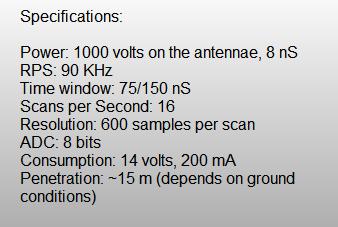|


GRP (Ground Penetrating Radar) is a device, which emits a very short impulses of radiowaves (2-10 nS, 100-1000 Volts) into the ground, and receives the reflections of these radiowaves. The GPR receives these reflections (distorted by the media being probed - ground), and the information is being passed to a software on a PC, to be displayed, logged and analysed.
Few years ago, we decided to make a GPR, and after a lot of research, we came to the conclusion that there are very few GPRs, are able to show the result of their work in real-time - what is under person's feet "right here, right now", and even few GPRs, that an average non-professional can afford to buy. In other words, there are almost no GPRs in a "low-cost band", destined for surveys conducted of a sole surveyor. Here is why we decided to develop an affordable GPR that shows results right there on the field, able to show it in a different comprehensive ways, and also able to store the collected data in convenient file formats for later analysis.
We sell GPRs, which satisfy the expectations from such a device.
After many tests, we concluded that GPR, as all GPRs in general, are very good in finding cavities, faults in bedrocks, buried building remains. We have to mention that soil properties have a substantial effect on the survey's results. Different types of soil have different conductivity. You should expect worse results when using the GPR on wet or loamy soil.
GPRs do recognize cavities in the ground, they can not "see" buried metal objects, neither can "see" such metal items in cavities, unless they are very big - in size of a car.
Considering abilities of the GPRs and the needs of the average treasure hunter, we made a GPR, which has almost all functions and capabilities of the high-cost GPRs, and most of all, a GPR you can easily work with, without the need of reading long manuals, video and phone tutoring. Just get it and get to work.
|
![]() تبادل
لینک هوشمند
تبادل
لینک هوشمند
![]()













